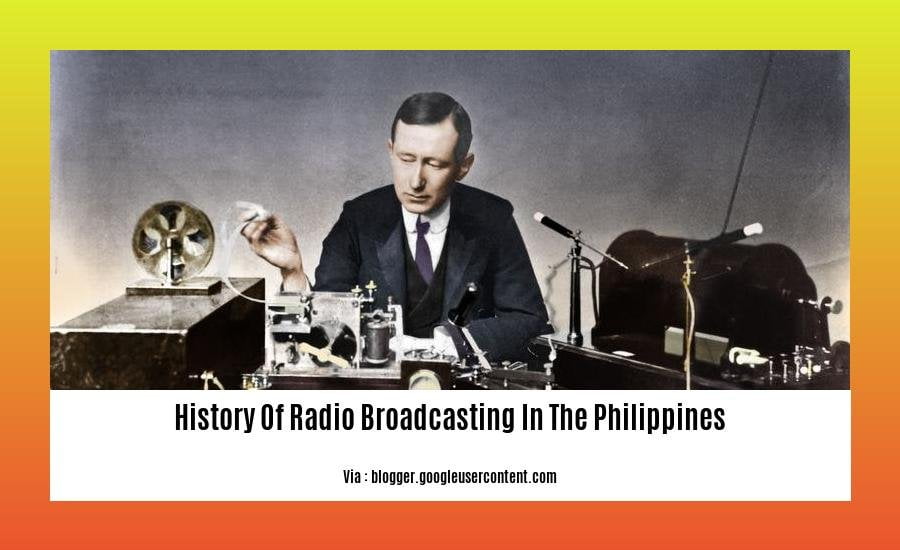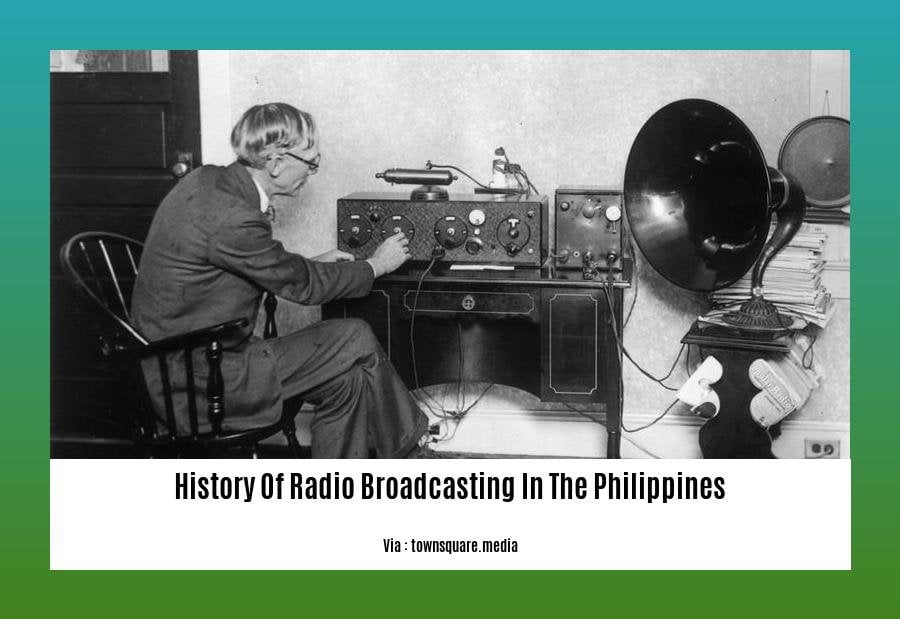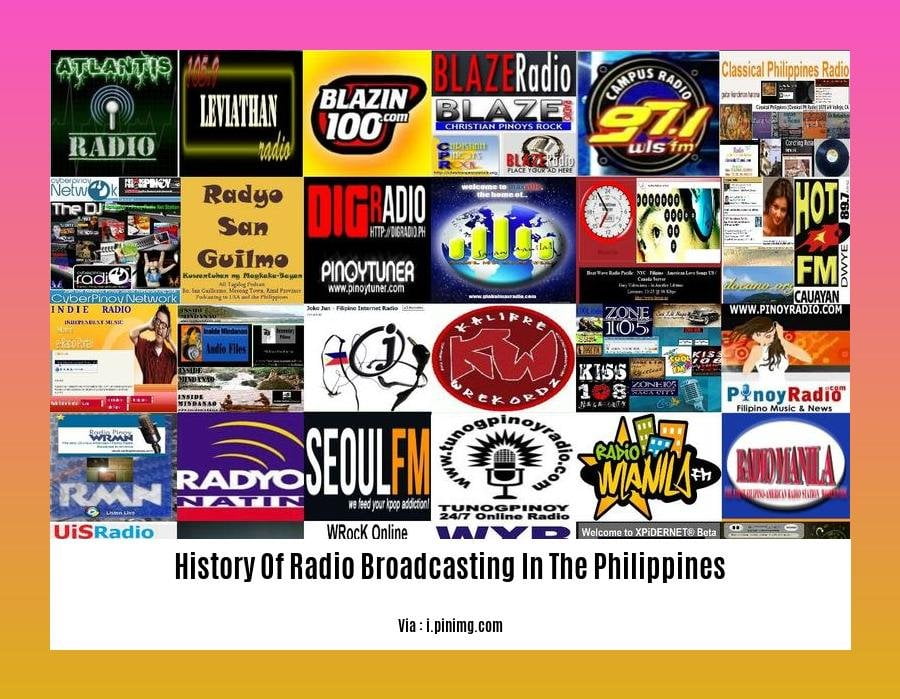Embark on a historical journey through the airwaves of the Philippines as we explore the evolution of radio broadcasting in the country. From its humble beginnings to its transformative impact on society and culture, discover how radio has played a pivotal role in shaping the nation’s identity. Tune in to “The History of Radio Broadcasting in the Philippines: A History of Airwaves and Cultural Exchange” to uncover the stories, personalities, and milestones that have shaped the Philippine broadcasting landscape.
Key Takeaways:
- The history of radio broadcasting in the Philippines can be traced back to the establishment of KZKZ (AM) in Manila in 1924.
- The Philippine Broadcast Code was issued in 2007 by the Kapisanan ng mga Brodkaster ng Pilipinas (KBP) to set standards for radio stations’ performance and ethical conduct.
- The Center for Media Freedom and Responsibility and the National Union of Journalists of the Philippines monitor acts of violence against radio commentators and other media members.
History of Radio Broadcasting in the Philippines

Radio broadcasting in the Philippines has played a pivotal role in shaping the country’s cultural landscape. From the crackly transmissions of the early 20th century to the vibrant FM airwaves of today, radio has been a constant companion to Filipinos, providing information, entertainment, and connecting communities. It has also served as a platform for expressing dissent, fostering cultural exchange, and promoting national identity. Throughout its history, radio broadcasting has reflected the Philippines’ rich cultural heritage, its struggles for freedom, and its aspirations for progress.
Early Years: The Pioneers
The history of radio broadcasting in the Philippines begins in 1922 when Antonio Quirino, a Filipino businessman, established the country’s first radio station, KZRM (now DZRH). The station’s initial broadcasts featured live music, news, and public service announcements. In 1924, the Philippine Broadcasting Corporation (PBC) was formed, and it soon became the dominant player in the radio industry. PBC’s programming included a mix of local and international content, and it played a crucial role in promoting Philippine culture and identity.
The Golden Age of Radio
The 1950s and 1960s marked the golden age of radio broadcasting in the Philippines. During this time, radio stations proliferated, and the airwaves were filled with a diverse range of programming. Popular radio programs included drama serials, comedy shows, and live musical performances. Radio also became a powerful tool for political and social activism, with many stations playing a key role in the struggle against the Marcos dictatorship.
The Digital Revolution
The advent of the digital age has brought about significant changes to the radio broadcasting landscape in the Philippines. Traditional AM and FM radio stations have had to adapt to the rise of online streaming, satellite radio, and podcasting. While these new technologies have posed challenges to the traditional radio industry, they have also opened up new opportunities for content creators and broadcasters.
The Future of Radio
Radio broadcasting in the Philippines is poised for continued growth and innovation. As the country’s population continues to grow and diversify, so too will the demand for diverse and engaging radio content. Traditional radio stations will need to continue to adapt to the changing media landscape, while new technologies will offer exciting opportunities for broadcasters and content creators.
Impact of Radio Broadcasting in the Philippines:
Information and Education: Radio has been a vital source of information and education for Filipinos, especially in remote areas where access to other media is limited.
Entertainment: Radio has provided Filipinos with a wide range of entertainment, from music to drama to comedy.
Cultural Exchange: Radio has played a key role in promoting cultural exchange, both within the Philippines and with other countries.
National Identity: Radio has helped to foster a sense of national identity among Filipinos, by broadcasting news and information from all over the country.
Social Change: Radio has been used to promote social change, by raising awareness of important issues and providing a platform for discussion and debate.
History of Quezon – Looking for a comprehensive overview of the captivating history that shaped the province of Quezon? Dive into our extensive exploration now.
History of Quezon Province – Embark on a journey through time to discover the rich narrative of how Quezon Province came to be.
The Role of Radio in Philippine Society: Information, Entertainment, and Public Discourse
In the Philippines, radio has been an enduring force in shaping the nation’s cultural landscape, serving as an indispensable source of information, entertainment, and public discourse. Since its inception in the early 20th century, radio broadcasting has left an indelible mark on Filipino society, weaving its way into the fabric of everyday life, connecting communities, and influencing the course of history.
Information:
Radio’s role as a provider of information has been crucial, especially in regions lacking access to conventional media platforms. Through the airwaves, Filipinos have been able to stay abreast of current events, government announcements, and vital public service messages, fostering a sense of informed citizenship.
Entertainment:
Radio’s programming has been a rich tapestry of entertainment, catering to diverse tastes and preferences. From lively musical shows to captivating dramas and comedy skits, radio has provided Filipinos with a much-needed escape from the daily grind.
Public Discourse:
Radio has served as a powerful platform for public discourse, enabling Filipinos to engage in discussions on matters of national importance. Talk shows, debates, and open forums have fostered a culture of informed dialogue, shaping public opinion and promoting civic engagement.
Key Takeaways:
Information Lifeline: Radio has been a lifeline for information, especially in remote areas, bridging the gap in access to news and essential announcements.
Cultural Catalyst: Radio has played a pivotal role in promoting Filipino culture, showcasing local music, languages, and traditions, and fostering a sense of national identity.
Champion of the Masses: Radio has been a champion of the masses, giving voice to the concerns and aspirations of ordinary Filipinos.
Historical Legacy: Radio’s rich history is intertwined with the Philippines’ journey as a nation, serving as a witness to key events and contributing to the country’s cultural heritage.
Entertainment Pioneer: Radio pioneered the concept of on-air entertainment, providing Filipinos with music, drama, comedy, and a wealth of other programming.
Public Forum: Radio has been a forum for public discourse, stimulating discussions and debates on social, political, and economic issues, shaping public opinion.
Sources:
[1]
[2]
The Impact of Technology on Philippine Radio: From AM to FM and Beyond

Key Takeaways:
Philippine radio broadcasting has undergone a profound transformation, transitioning from AM to FM and embracing digital technologies.
AM radio paved the way for the dissemination of information and entertainment, shaping the cultural landscape of the Philippines.
FM radio introduced higher fidelity sound quality and expanded programming options, revolutionizing the listening experience.
The advent of digital technology brought about online streaming and podcasting, enabling radio content to reach a global audience and cater to niche listening preferences.
Despite these advancements, traditional AM and FM radio stations remain resilient, adapting to the digital age by incorporating online platforms and hybrid broadcasting models.
The history of radio broadcasting in the Philippines is a fascinating journey that mirrors the country’s socio-political and technological evolution. From the humble beginnings of AM radio to the rise of FM and the digital revolution, radio has played a pivotal role in shaping the nation’s cultural identity and providing a powerful platform for information and entertainment.
### AM Radio: The Pioneer of Philippine Airwaves
AM radio, with its distinctive static-laced sound, was the trailblazer of Philippine broadcasting. The establishment of KZRM (now DZRH) in 1922 marked the dawn of a new era in communication. AM radio quickly gained popularity, becoming a primary source of news, music, and entertainment for Filipinos.
### FM Radio: Ushering in a New Era of Sound Quality
In the 1970s, FM radio emerged as a game-changer in the broadcasting industry. With its superior sound quality, FM offered a more immersive listening experience, capturing the attention of a growing audience. FM stations proliferated, expanding the range of programming options and catering to diverse listening preferences.
### Digital Revolution: Transforming Radio Broadcasting
The advent of digital technology brought about a profound transformation in the world of radio broadcasting. Online streaming platforms and podcasting revolutionized the way Filipinos consumed radio content. Streaming allowed listeners to access radio stations from anywhere in the world, while podcasting opened doors for independent content creators to share their unique perspectives and reach a global audience.
### Embracing the Digital Age: Hybrid Broadcasting Models
Despite the rise of digital platforms, traditional AM and FM radio stations have demonstrated remarkable resilience by adapting to the changing landscape. Many stations have embraced hybrid broadcasting models, seamlessly integrating online streaming with their terrestrial broadcasts. This strategic move has enabled them to expand their reach and cater to a wider audience, ensuring the continued relevance of radio in the digital age.
### Conclusion: The Enduring Legacy of Radio Broadcasting
Radio broadcasting in the Philippines has come a long way since its humble beginnings in the early 20th century. Through the decades, it has evolved, adapted, and thrived, reflecting the dynamism of Philippine society and the ever-changing technological landscape. From AM to FM and now to the digital realm, radio continues to play a vital role in informing, entertaining, and connecting Filipinos across the globe.
Citation:
Filipino Community Radio Stations Struggle to Survive Amid Global Voices
The Future of Radio Broadcasting in the Philippines: Adapting to the Digital Age
Radio broadcasting in the Philippines has a rich history, having served as a primary source of entertainment and information for generations. In the digital age, the medium is undergoing a transformation as it adapts to new technologies and changing audience preferences.
The Impact of Digital Technology
The proliferation of smartphones, tablets, and other mobile devices has led to a significant shift in the way people consume media. Traditional radio broadcasting, which relies on terrestrial transmission, has been challenged by the rise of online radio stations and streaming services. These digital platforms offer convenience, accessibility, and a wider variety of content, making them increasingly popular among listeners.
Embracing Digital Transformation
In response to the changing landscape, radio stations in the Philippines are embracing digital transformation strategies to stay relevant and engage with audiences. Many stations have launched their own websites and mobile apps, allowing listeners to stream their content online. They are also utilizing social media platforms to connect with listeners, share news and updates, and promote their programming.
Creating New Opportunities
The digital transformation of radio broadcasting has created new opportunities for content creation and distribution. Radio stations can now produce and distribute podcasts, webcasts, and digital audio content, catering to diverse audience interests and expanding their reach beyond traditional broadcast limits.
Challenges and the Road Ahead
Despite the opportunities presented by digital technology, radio broadcasting in the Philippines faces several challenges. One challenge is the need for reliable and affordable internet access, particularly in remote areas. Additionally, radio stations need to invest in the necessary infrastructure and expertise to produce and distribute digital content effectively.
Key Takeaways:
The digital age has brought about significant changes to radio broadcasting in the Philippines.
Radio stations are embracing digital transformation strategies to stay relevant and engage with audiences.
Digital platforms offer convenience, accessibility, and a wider variety of content, making them increasingly popular among listeners.
Radio stations are creating new opportunities for content creation and distribution through digital technologies, such as podcasts and webcasts.
Challenges include the need for reliable and affordable internet access, as well as investment in infrastructure and expertise.
Relevant URL Sources:
– Radio broadcasting in the digital age: Adapting to the challenges of the 21st century
– Digital Transformation of Radio Broadcasting: An Exploratory Study
FAQ
Q1: What was the first radio station established in the Philippines?
A1: The first radio station in the Philippines was KZKZ (AM), which began broadcasting in Manila in 1924.
Q2: What is the Philippine Broadcast Code, and how does it regulate radio broadcasting in the Philippines?
A2: The Philippine Broadcast Code, issued in 2007 by the Kapisanan ng mga Brodkaster ng Pilipinas (KBP), sets professional and ethical standards for radio stations, ensuring responsible and ethical broadcasting practices.
Q3: How has radio broadcasting evolved in the digital age in the Philippines?
A3: In the digital age, radio broadcasting in the Philippines has undergone a transformation, with the emergence of online radio stations and streaming services, allowing for greater convenience and accessibility for listeners. Radio stations have also embraced digital platforms to expand their reach, engage with listeners, and offer interactive experiences.
Q4: What are some of the challenges faced by community radio stations in the Philippines?
A4: Community radio stations in the Philippines encounter various challenges, including land-grabbing, demolition, environmental destruction, militarization, human rights violations, labor violations, and financial difficulties, which hinder their ability to provide information and empower communities.
Q5: How has radio broadcasting contributed to cultural exchange in the Philippines?
A5: Radio broadcasting in the Philippines has played a substantial role in cultural exchange by disseminating information, music, and cultural programs across the country, fostering a sense of national identity and promoting understanding and appreciation of diverse cultural expressions.












